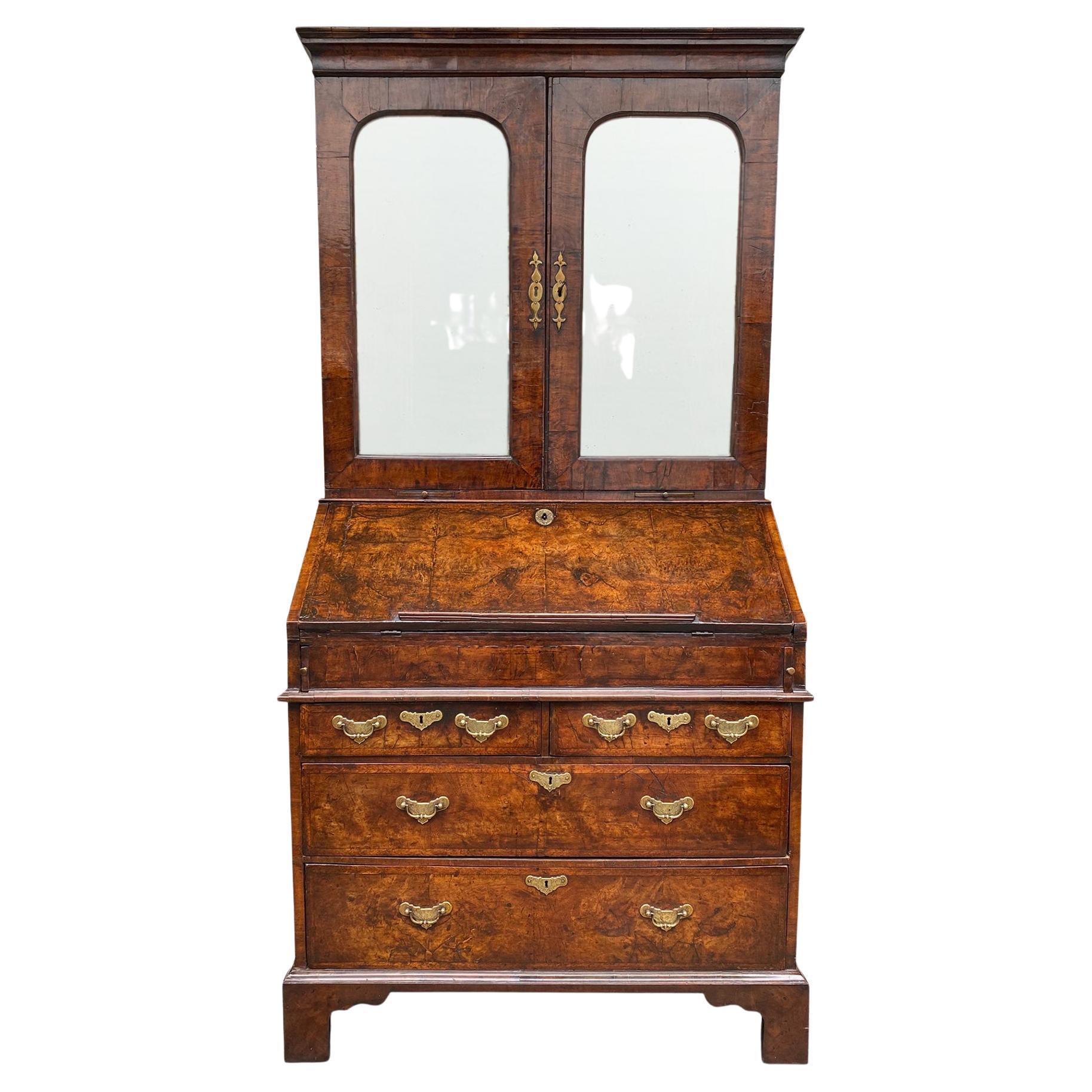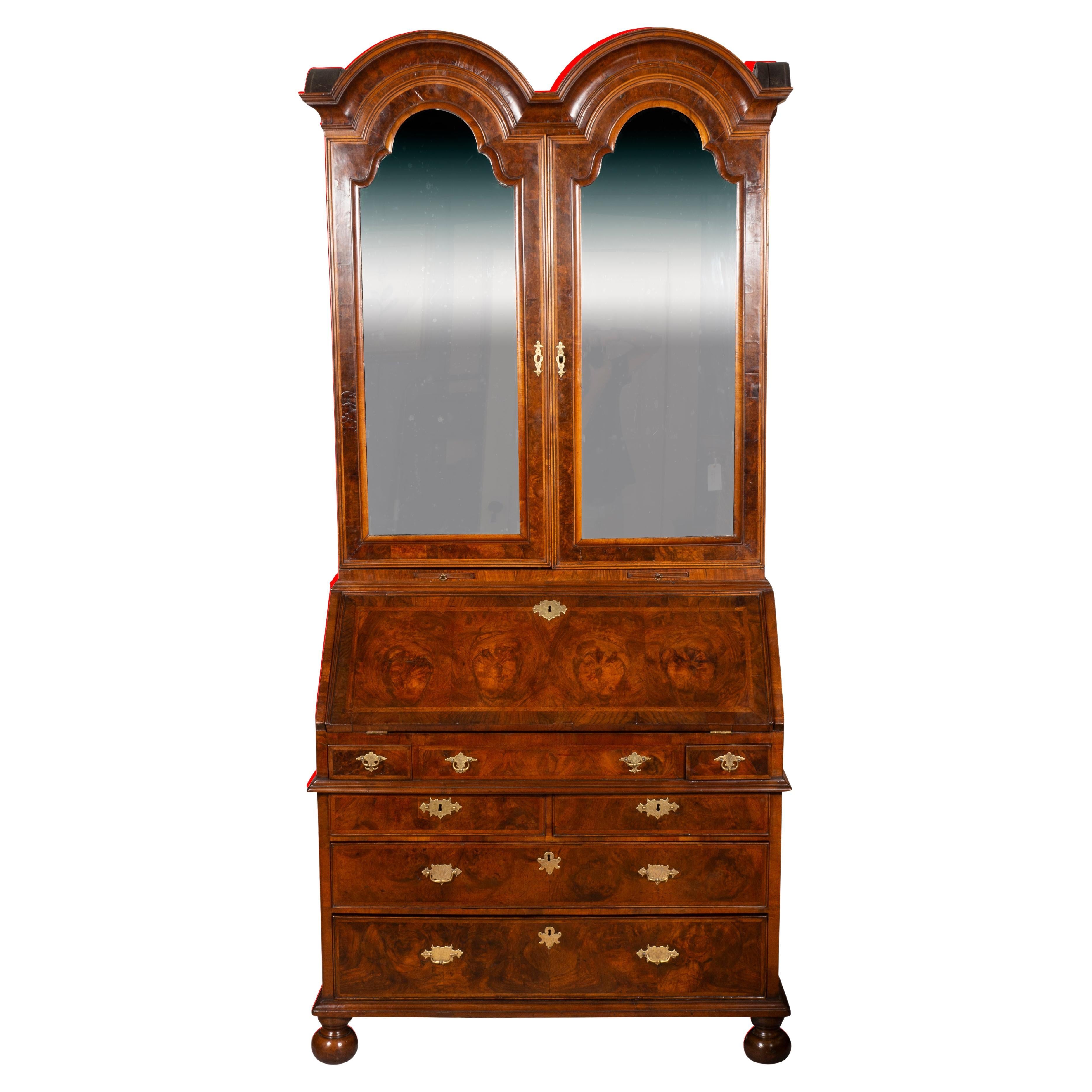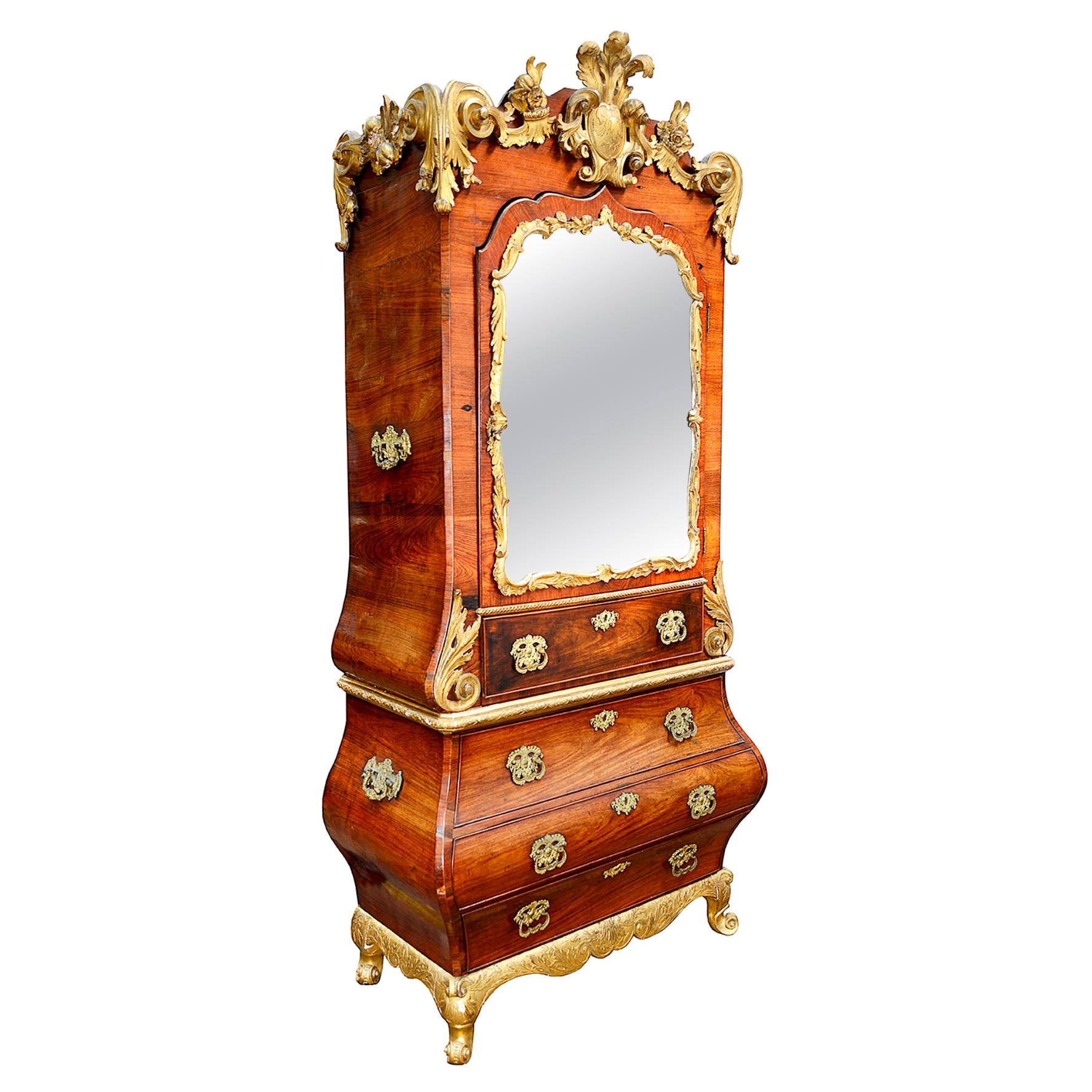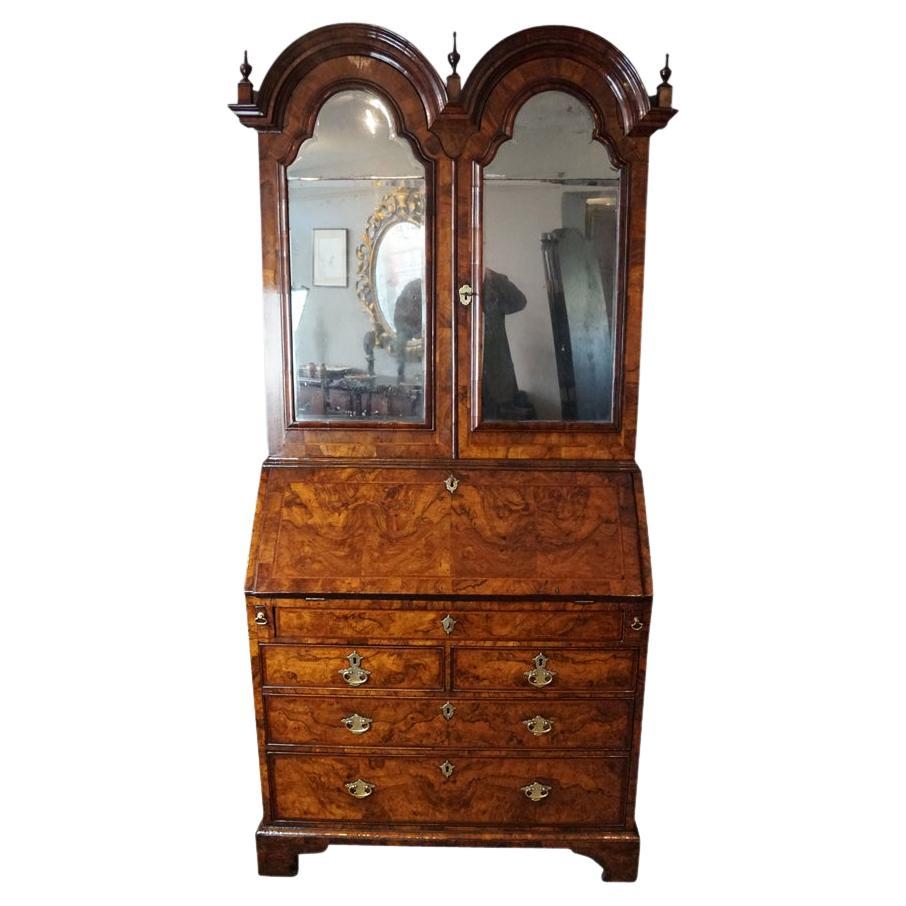Items Similar to Bookcase Bureau Walnut Burr Original Mirror Plate Bevelled Double Dome Finials
Want more images or videos?
Request additional images or videos from the seller
1 of 12
Bookcase Bureau Walnut Burr Original Mirror Plate Bevelled Double Dome Finials
About the Item
AN EXCEPTIONAL, GEORGE I, BURR WALNUT & FEATHER BANDED, DOUBLE-DOMED BUREAU BOOKCASE WITH ORIGINAL BEVELLED MIRROR PLATES, GILDED FINIALS, FROM THE COLLECTION OF RONALD LEE
- The double dome cornice was a complex and admired Baroque form used in the finest cabinet pieces
- This is an exceptional early-18th century, cabinet piece, incorporating the most elaborate and expensive features found in the best pieces from this era. The gilded finials, double dome, bevelled mirror plates, candle slides, finely figured burr walnut veneers, double feather banding, brassware engraved with flowers and foliage, secret drawers, drawers fitted in the frieze.
- This model in three sections is rare, and it is more practical and aesthetically pleasing to have the two drawers fitted into what is more commonly a plain frieze below the bureau section.
- PROVENANCE : Private Collection, Ronald Lee Collection. I acquired this piece the daughter of Ronald Lee 20 years ago and it has been in a private collection since then. It has come back into my hands due to family bereavement.
- The original, arched, bevelled mirror plates were elite items due to their expense and highly desirable for their reflective quality.
- The burr veneers are book-matched throughout to create a striking, finely figured, decorative effect.
- The central pigeon hole section is removeable and reveals secret drawers behind the small drawers with shelves above.
- This bureau bookcase is in exceptional condition retaining original, finials, mirror plates, brassware and bracket feet. It also retains its original rich colour and lustrous patina.
Just purchased more information to follow. The photographs were taken by me with an iphone and do this piece no justice
- Dimensions:Height: 0.4 in (1 cm)Width: 0.4 in (1 cm)Depth: 0.4 in (1 cm)
- Style:Baroque (Of the Period)
- Materials and Techniques:
- Place of Origin:
- Period:1720-1729
- Date of Manufacture:c1720
- Condition:Repaired: minor repairs to veneer loss. Wear consistent with age and use.
- Seller Location:BUNGAY, GB
- Reference Number:1stDibs: LU3867331927112
About the Seller
5.0
Vetted Seller
These experienced sellers undergo a comprehensive evaluation by our team of in-house experts.
Established in 1985
1stDibs seller since 2018
87 sales on 1stDibs
Typical response time: 19 hours
- ShippingRetrieving quote...Ships From: BUNGAY, United Kingdom
- Return PolicyA return for this item may be initiated within 7 days of delivery.
More From This SellerView All
- Bureau Bookcase Oak German Serpentine Front Original Brassware Working LocksLocated in BUNGAY, SUFFOLKA large, museum quality, 18th century, German, oak bureau bookcase with a serpentine front, original brassware and working locks As fine an example of this model of German cabinet f...Category
Antique 1740s German Rococo Desks
MaterialsOak
- Cassettone Bureau-Chest Bambocci 16century Italian Renaissance Walnut LombardyLocated in BUNGAY, SUFFOLKAN EXCEPTIONAL MUSEUM QUALITY, ITALIAN, RENAISANCE WALNUT CASSETTONE WITH A FITTED BUREAU IN THE UPPER PART & EXCEPTIONAL BAMBOCCI CARVING, LOMBARDY - This exceptionally rare, museum quality, piece of early furniture was conceived and crafted as an artwork of the finest quality of its time. Throughout time it has been a luxurious, statement piece which has protected it, and fortunately it has survived in virtually, original condition. - This magnificent cassettone exudes the character and quality of the finest, late-Renaissance furniture. Northern Italian Renaissance furniture often had the sides, legs or angles, 'a Bambocci', incorporating carved figures which were considered unique sculptures in their own right. - The putti on this cassettone are beautifully carved and of sculptural quality. Each angel has one arm raised to heaven, a poignant touch. - The lion’s paw feet are a classical feature and make a great statement. - This cassettone was conceived to have visual impact through the quality of the carving, as well as being very practical with the writing compartment fitted in the top part. - It has survived in very original condition with a few small repairs and losses, and the colour and patina are warm and lustrous. - This cassettone is illustrated Illustrated in C. Alberici, Il Mobile Lombardo, Milan, 1969, p. 45, one of the seminal works on Lombardy furniture, and has been in two renowned collections. The hinged top in two sections faced with a solid moulded edge. The front part has a fall front and opens to reveal a writing compartment. The fall front retains its original lock and is concealed with a false drawer which is above three drawers. All with moulded panels, escutcheons and retaining the original iron handles. The front ends have exceptional, bambocci, carved putti raising their arms to heaven above trailing foliage. Standing on magnificent lion's-head carved feet. The sides are panelled. Exceptional original colour and patina. Literature : Illustrated in C. Alberici, Il Mobile Lombardo, Milan, 1969, p. 45. A Gonzalez-Palacois, Il mobile in Liguria, Genova, 1996 illustrates related pieces Measures: Length 147 ½ cm. 58 in, height 104 cm. 41 in, depth 75 cm. 29½ in, Provenance: Coll. Private Azzate The Collection of Sandro and Lidia Orsi, Ca’ Mera, Varese. Regarded as one of the most beautiful homes in Lombardy, Ca’ Mera, the country house of Sandro and Lidia Orsi was filled with beautiful objects from many different epochs. A renowned antiquarian from Milan, over his lifetime Sandro and his wife Lidia revived the Renaissance and Baroque character of the house and instilled their own unique vision into the interiors, which culminated with the creation of a Kunst – or Wunderkammer. “I have never seen such an example of poetical taste”, Sir John Pope...Category
Antique 16th Century Italian Renaissance Commodes and Chests of Drawers
MaterialsWalnut
- Cassetone Bureau Desk Ebonised Rosewood Bone Rome Baroque Bird Flower Lion TulipLocated in BUNGAY, SUFFOLKExceptional Roman Baroque Ebonised, Rosewood Cassettone with bone inlay and magnificent brass handles Magnificent transition piece displaying classical ornamentation within a tradit...Category
Antique 1690s Italian Baroque Commodes and Chests of Drawers
MaterialsBone, Ebony, Rosewood
- Bureau Desk Fall Front Japanning Tortoishell Gilding ChinoiserieLocated in BUNGAY, SUFFOLKA rare, late-17th century / early-18th century, fall front bureau with gilded Chinoiserie Japanning & faux tortoishell ground. “Before Japan was made in England, the imitation of tortoise-shell was much in request for cabinets, tables and the like“. John Stalker and George Parker, a treatise on Japanning and varnishing (originally published in 1668), Alec Tiranti, 1998, p. 75. - This bureau is decorated in one of the most fashionable styles of the Baroque period, Chinese lacquer with gilded decoration and tortoiseshell imitation ground and would have been a statement piece within the interior. - The colours, which have become muted from atmospheric conditions over time, are still striking and colourful evoking warm and richness. - It has come from a private collection where it has reputedly been for many generations which explains why it is in such original condition retaining the original hinges, lock and catches. - Pieces of imitation tortoishell with gilded lacquer decoration are rare, the last piece I handled was a chest of drawers about 20 years ago. - Tortoishell furniture was only affordable by royalty and the elite and the height of fashion in the 17th century, as was producing things that were not what they seemed. One of the oldest examples of faux material from the Baroque period is at Rosenborg Castle in Copenhagen where, in 1667, the royal bed...Category
Antique 17th Century Italian Chinoiserie Desks
MaterialsLacquer
- Vargueno, Bargueno, Escritorio, Taquillon, Spanish, Baroque, Walnut, VelvetLocated in BUNGAY, SUFFOLKSpanish writing desks of this period are the most distinctive pieces of Spanish furniture conceived as visual displays of incredible virtuosity. The characteristic decoration of the ...Category
Antique Early 17th Century Spanish Baroque Cabinets
MaterialsWalnut
- Bookcase Folding Flat TeakLocated in BUNGAY, SUFFOLKAn unusual and ingenious, mid-century modern retro, portable, folding table top bookcase or display shelf. Slatted supports with three shelves folding flat. Light and easy to carry. Versatile folding mechanism for display, books or bathroom shelves...Category
20th Century French Mid-Century Modern Bookcases
MaterialsTeak
You May Also Like
- Very Fine 18th Century George I Period Burr Walnut Bureau BookcaseLocated in Petworth,West Sussex, GBA very fine George I period walnut and feather banded bureau bookcase, circa 1720, the moulded cornice above a pair of mirror panelled doors, ope...Category
Antique Early 18th Century British George I Bookcases
MaterialsMirror, Walnut, Burl
- Antique William and Mary Outstanding Burr Walnut Double Dome Bureau BookcaseLocated in Suffolk, GBAntique William and Mary outstanding quality burr walnut inlaid marquetry double dome bureau bookcase having an outstanding quality double dome shaped top with a moulded cornice abov...Category
Antique 17th Century English William and Mary Bookcases
MaterialsWalnut
- George II Walnut Double Dome Bureau BookcaseLocated in Essex, MAWith double arch top over a pair of mirror doors opening to an elaborately fitted interior, the base with two candle slides and hinged slant lid writing ...Category
Antique 1730s English George II Secretaires
MaterialsWalnut
- Early 18th Century George I Figured Walnut Bureau BookcaseBy Peter MillerLocated in Oxfordshire, United KingdomA superb and exceptionally well proportioned early 18th century figured walnut ‘pagoda topped’ double dome bureau bookcase, circa 1720 England. The upper section is surmounted with what is believed to be the original solid walnut finials and soft bevelled mirror plates, opening to a removal bank of walnut veneered and feather banded drawers, cantered by pigeonholes below two shelves. Candle slides are neatly stowed below the bookcase doors to reflect the light. To the moulded bureau, the fall opens to reveal pigeonholes, long and short asymmetric drawers each beautifully veneered in figured walnut and feather banded, cantered by a cupboard door which neatly conceals an open compartment and drawer. Below the fall, two short and two long graduating oak lined drawers are each book-matched in superb sections of hand-cut figured walnut veneers over bun feet. It should be noted that this exceptional desk and bookcase, is not only of the finest cuts of figured walnut veneer but exquisitely made at the pinnacle of design which had gradually evolved predominantly in London, during the late 17thand early 18thcentury. The actual description 'desk-and-bookcase' appears to be first recorded in the accounts of the Royal cabinet-maker Gerrit Jensen (fl.1680-d.1715) who supplied several for the Royal Household from 1710 (Bowett, op. cit.), and another described as 'a walnut writing desk, the top for books and patons and glass in the doors asked' for the 5th Earl of Salisbury, Hatfield House. Another maker of this form of desk was the London cabinet-maker John Gumley (1691-1727) who advertised in Richard Steele's Lover on April 24 1714 that he 'hath taken for a Ware-house, and furnished all the upper part of the New Exchange in the Strand' continuing with an extensive list of his stock including 'Desks and Bookcases.' In 1714 he supplied one of these in walnut to James 1st Duke of Montrose for the sum of £11. Russian cabinetwork of this period was strongly influenced by Tsar Peter I return to Russia after his studies in London. He subsequently sent twenty-four cabinetmakers who were working in Amsterdam to London to train as furniture makers. One of these cabinetmakers named Fedor Martynov made furniture for the Empress Anna Ioannovna. Martynovs drawings are almost identical to the present piece. Literature Mallett’s Great English Furniture, London: Bullfinch Press 1991, p.248, fig 287, by Lanto Synge, English Furniture 1660-1714 From Charles II to Queen Anne, by Dr Adam Bowett, Woodbridge: Antique Collector’s Club, 2002 Chapter 7 Case Furniture 1689–1714 pp.221-223 fig. 7:53 A walnut bureau bookcase of the same form and period sold from the private collection of Patricia Kluge...Category
Antique Early 18th Century British George I Bookcases
MaterialsWalnut
- 18th Century Scandanvian Rococo Giltwood and Walnut Bureau BookcaseLocated in Brighton, SussexA very impressive 18th Century Rococo carved giltwood and Walnut bureau bookcase, having wonderful scrolling foliate and plume decoration to the cornice, a single mirror door with gi...Category
Antique Late 18th Century Scandinavian Rococo Desks
MaterialsWalnut, Giltwood
- English Country House George I Walnut Double Dome Bureau BookcaseLocated in Salisbury, GBVery rare George I double dome walnut bureau bookcase, it is of a smaller than the regular size and so can fit in most homes. This George I walnut bureau bookcase...Category
Antique 1720s British George I Desks
MaterialsWalnut
Recently Viewed
View AllMore Ways To Browse
Mirrored Plates
Original Finial
Antique Mirror Plate
Flower Finial
Bevelled Mirror Pieces
Antique Mirror With Shelves
Burr Veneer
Bureau Used
Antique Photograph Plates
Gilded Finials
Giltwood Finials
Small Walnut Mirror
I Finity
Plates With Feathers
Double Bookcase
Expensive Mirrors
Antique Small Bookcase
Small Antique Bookcases





